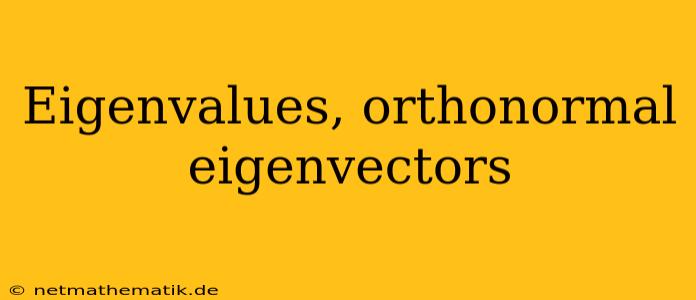Unveiling the Essence of Eigenvalues and Orthonormal Eigenvectors
In the realm of linear algebra, the concepts of eigenvalues and eigenvectors hold paramount significance. These fundamental tools provide invaluable insights into the behavior of linear transformations, offering a powerful framework for analyzing and understanding complex systems. Eigenvalues, essentially scalar values, quantify the extent to which a linear transformation stretches or shrinks a specific vector, known as an eigenvector. Orthonormal eigenvectors, a special class of eigenvectors, possess the remarkable property of forming a mutually perpendicular and normalized basis, simplifying intricate transformations and revealing hidden structures within data. This article delves into the intricacies of eigenvalues and orthonormal eigenvectors, exploring their definitions, properties, and profound applications across diverse fields.
Eigenvalues: The Essence of Transformation
At its core, an eigenvalue represents the factor by which a linear transformation scales a corresponding eigenvector. Consider a linear transformation represented by a matrix A and a vector x. If applying the transformation to x results in a scalar multiple of x, then x is an eigenvector of A, and the scalar is its eigenvalue. Mathematically, this relationship is expressed as:
Ax = λx
where:
- A is the transformation matrix
- x is the eigenvector
- λ is the eigenvalue
This equation signifies that applying the transformation A to the eigenvector x yields a scaled version of the same eigenvector, with the scaling factor being the eigenvalue λ.
Orthonormal Eigenvectors: A Foundation for Simplification
While eigenvalues reveal how a transformation scales eigenvectors, orthonormal eigenvectors add another layer of elegance and utility. An eigenvector is considered orthonormal when it satisfies two crucial properties:
- Orthogonality: Two eigenvectors are orthogonal if their dot product is zero, implying they are perpendicular to each other.
- Normalization: An eigenvector is normalized when its magnitude (length) is equal to 1.
The significance of orthonormal eigenvectors lies in their ability to form a basis, a set of linearly independent vectors that span the entire vector space. When a set of eigenvectors is orthonormal, they form an orthonormal basis, offering several advantages:
- Simplification: Orthonormal eigenvectors simplify linear transformations, making them easier to analyze and understand.
- Decomposition: Any vector within the vector space can be expressed as a linear combination of the orthonormal eigenvectors, providing a convenient way to decompose complex vectors into simpler components.
- Coordinate System: Orthonormal eigenvectors form a unique coordinate system within the vector space, allowing for a more intuitive representation of data and transformations.
Applications of Eigenvalues and Orthonormal Eigenvectors
The profound impact of eigenvalues and orthonormal eigenvectors extends far beyond theoretical concepts, finding practical applications across a wide range of disciplines.
-
**** Data Analysis: In fields like machine learning and data science, eigenvalues and eigenvectors play a crucial role in dimensionality reduction techniques like Principal Component Analysis (PCA). By identifying the eigenvectors corresponding to the largest eigenvalues, PCA allows for data compression and noise reduction, while preserving the most significant information.
-
**** Physics: Eigenvalues and eigenvectors are fundamental in quantum mechanics, where they govern the behavior of particles and systems. For instance, in the realm of atomic physics, eigenvalues represent energy levels of electrons, and eigenvectors describe the corresponding electron states.
-
**** Engineering: In structural engineering, eigenvalues and eigenvectors help determine the natural frequencies and vibration modes of structures, essential for ensuring safety and stability. In control systems engineering, they aid in analyzing the stability of feedback systems.
-
**** Computer Graphics: In computer graphics, eigenvalues and eigenvectors contribute to techniques like image compression and object deformation, enabling the efficient representation and manipulation of complex visual data.
-
**** Network Analysis: In network analysis, eigenvalues and eigenvectors help understand the connectivity and flow of information within complex networks, aiding in identifying key nodes and bottlenecks.
Examples of Eigenvalues and Orthonormal Eigenvectors in Action
To illustrate the practical significance of eigenvalues and orthonormal eigenvectors, consider a simple example involving a rotation transformation in a two-dimensional plane.
Let's say we have a matrix A that represents a 90-degree counter-clockwise rotation. Applying this transformation to a vector x will rotate it by 90 degrees.
The eigenvector corresponding to this transformation is a vector that remains unchanged in direction after the rotation, only being scaled by a factor of 1. In this case, the eigenvector is the vector [1, 0], as rotating it by 90 degrees simply changes its orientation from horizontal to vertical, without altering its direction. The eigenvalue associated with this eigenvector is 1, indicating that the transformation does not scale the eigenvector.
Similarly, the other eigenvector is [0, 1], which rotates from vertical to horizontal, again without changing its direction. The eigenvalue for this eigenvector is also 1.
These two eigenvectors, [1, 0] and [0, 1], are orthogonal since their dot product is zero, and they are normalized since their lengths are 1. Together, they form an orthonormal basis for the two-dimensional space, enabling the representation of any vector in this space as a linear combination of these two orthonormal eigenvectors.
Conclusion
Eigenvalues and orthonormal eigenvectors provide a powerful framework for understanding and analyzing linear transformations across diverse fields. By quantifying the scaling effects of transformations and providing a simplified basis for vector spaces, these concepts offer invaluable insights into the behavior of complex systems. Whether analyzing data, exploring physical phenomena, or designing engineering solutions, the application of eigenvalues and orthonormal eigenvectors empowers us to gain deeper understanding and solve intricate problems with elegance and efficiency.
